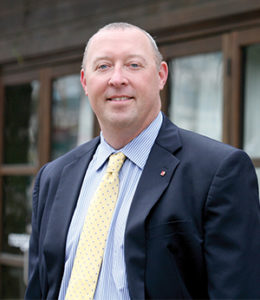Design Roundtable: Change Manifests Quickly with Emerging Design Trends
By Daedalus Howell
When it comes to emerging trends in the corrections design, no song lyric more aptly captures the moment than David Bowie’s “Ch-ch-ch-changes!” From personal technology entering correctional facilities to a greater emphasis on rehabilitation, many changes are afoot. In this design roundtable, Correctional News spoke with four justice design architects for their takes on what’s next. Among them were Beverly Prior, FAIA, NCARB, LEED AP, vice president, justice lead, U.S. West for AECOM; Eric B. Ratts, AIA, principal architect at DLZ; Darrell Stelling, AIA, DLR Group’s global sector leader for the Justice+Civic studio; and Gerry Guerrero, AIA, DBIA, senior vice president, justice director of the justice practice for HOK.
Q: What design trends do you see developing more for the corrections market in the future?

Prior: Technology creates new opportunities for individual control. For example, the problem with TV noise and competing programs can be virtually eliminated through inmates using headsets to tune into and listen to their preferred programs. Better yet, hand-held individual pads give inmates self-directed entertainment and education. Even low-tech solutions such as eye masks can support better sleep in 24-7 artificially lit environments. More specialized treatment facilities with a step-down approach allow inmates to advance from higher security and higher-treatment care to moderate and then lower levels of security and treatment as inmates’ socialization and health improve. Wellness features such as access to nature, natural light, stress-reducing colors and murals [are also important].
Ratts: In our practice, we are seeing more and more jails evolving to become essentially rehabilitation centers as much as detention centers. Historically, jails have been designed to incarcerate the “bad criminals,” whereas today, societal issues are driving how we design facilities to be rehabilitation centers. Over the next 10 years, I believe more and more treatment facilities and hospitals will be teaming with corrections to develop a new hybrid of corrections.
Stelling: We are seeing a continued focus on normative environments as a means to meet the needs of inmates and staff wellness. That means using a broader spectrum of building materials, finishes and furnishings to not only create a more humane environment, but to also help promote a stronger community of people within the walls of a detention/corrections facility. Additionally, we are presenting, encouraging and hearing a renewed focus on rehabilitation instead of mass incarceration. The bottom line is that the vast majority of inmates are people who inevitably become our neighbors or co-workers. We want to reintroduce them to society with the skills and resources they need to succeed and contribute to their communities.

Due to this shift of cultural attitudes toward inmate populations, we are responding to a wide variety of studies related to operational/staffing efficiencies. We also see a big push to alternative sentencing and rehabilitation outside secure facilities, which allows us to focus on additional project types.
Technology is also making its way into rehabilitating inmates, and we are integrating these changes as we consider our design. Technology has a unique ability to personalize rehabilitation and offer humanitarian options in how inmates interact with family and community and in developing personalized learning plans. Technology has to be well thought out in how it is used as there is still no full substitution for human in-person visits.
Guerrero: I believe there are a number of design trends in the future of our industry. The medical and mental health initiative for proper and adequate treatment of those incarcerated will continue to have a major impact. Another is the large consolidated justice facilities in the larger metropolitan areas that consolidates their jail, juvenile and court systems (adult and juvenile) on one large site. There also is an uprise in design for the female and juvenile populations, specifically juvenile. Design for new juvenile facilities has been overlooked for the past 20 years. Similar to the adult system, there has finally been an acknowledgement that juveniles need similar care in regard to mental health, treatment and the normative environment.
Q: What recent trends have had the greatest affect on your personal approach to design?

Prior: The increasing number of inmates with mental health and substance-use disorders has had owners, treatment providers and architects alike digging in to understand how facilities and operations together can support individuals in institutional care. The shift in thinking from “inmate” to “patient” is a powerful paradigm change to supporting the whole person, providing opportunities for both socialization and privacy and utilizing the Well Building Institute’s scientific research into wellness to support physical and mental health.
Ratts: Two things steering our designs today: societal issues and the depth of qualified DECs in the industry. Societal issues (addictions and mental health) are challenging us to design differently as the old six-sided boxes simply do not work. Inmates today need much more [variety] in the types of spaces, as their crimes are different and thus their rehabilitation efforts are far different. In the past, architects simply did bed projection studies to determine how many additional beds were needed. Today, we are designing specific types of beds for the various types of inmates in facilities. We are creating environments where inmates have a better opportunity to be successful and thus reduce recidivism.
Stelling: The trend to design for the mentally ill in correctional facilities is probably the most active area of change in our approach to design. Correctional facilities, commonly called the largest mental health provider in the U.S., simply were not designed to adequately accommodate this need. Unless owners begin to incorporate physical changes to existing structures, there is the potential of doing more harm than good to individuals dealing with these issues. In a recent project, we paired mental health providers with correctional officers and designed to the mental health need as first priority. Then, the security requirements responded to that focus. This has resonated into all project types — juvenile, adult detention or correction, male or female. We are designing to the user’s needs first rather than the security need first.
Guerrero: Probably the greatest impact on the design approach is having a complete understanding of actually how much space needs to be allocated in order to design these facilities appropriately. I believe our industry for years has tried to make our facilities too lean. As professionals, we need to educate our clients, in addition to the public, with a complete understanding that in order to design these facilities appropriately for treatment and rehabilitation — and accomplish all the goals required to make this happen (e.g., sunlight, acoustics, personal space, proper materials, appropriate furniture and access to the natural environment) — requires adequate programming to avoid our profession designing these facilities too “lean.”
Q: How does design directly affect inmates in the context of rehab?
Prior: To support rehabilitation, design and operations need to work together. We can design to provide access to nature, sunlight, quality views, noise control, color, glare reduction, ability to walk around, individual controls, and appropriate spaces for socialization, privacy and treatment. Operators can provide programs, healthy food and respectful engagement.

Ratts: My thesis project was just this — how does the designed environment affect the individual? From my research and through my practice, I am endlessly working to develop designs that relate to the human needs. Correctional designs today are normalizing spaces that are filled with sunlight, views to the exterior, therapeutic color schemes and softer materials. We are seeing through our designs that inmates appear to be less stressed, which is leading to reduced incidents, assaults, and safer environments for the inmates and staff.
Stelling: Harsh environments create harsh or hardened people, and this is why it’s imperative that we begin to change that reality. These environments affect inmates and staff alike. So, we are asking different questions of our client agencies and listening to how we can best create spaces to facilitate behavioral change.
Design contributes to the context of rehabilitation, particularly as we create educational spaces. There is an art and a science to designing educational spaces that we bring to every client. Unfortunately, many older facilities found boxy concrete space for a chair, a desk and a white board and called it a classroom. Common sense as well as research tells us this is not an effective classroom setting. “So, we bring in our experts who are skilled at building community colleges or high schools and we integrate the best practices from these professionals into a secure environment. Our facilities more and more integrate daylighting, career technology spaces, flex learning spaces and many other elements that not only make a person feel human as they learn but literally make success a reachable goal. We are also working to integrate nature into design, giving inmates space for quiet study or reflection, or [to use] as an active agricultural/gardening space in the career education model.
Guerrero: Design plays a significant role in the treatment and rehabilitation of those incarcerated. The aspects of a design that have the greatest influence on anyone in a secure environment are lighting (both sunlight and artificial), acoustics and personal distance. We as designers need to understand the challenges of these basic human needs in a secure environment. We need to allow for the inclusion of these elements when developing our planning and operational concepts without compromising safety. Other elements such as colors, materials, appropriate furniture and access to natural elements play an integral part in rehabilitative design as well. We also need to be cognizant of the communities these types of facilities are located in and how they interact. Community involvement from service providers can have a significant impact on the rehabilitation process.
To read the entire article, check out the January/February issue of Correctional News.

